|
|
|
Sort Order |
|
|
|
Items / Page
|
|
|
|
|
|
|
| Srl | Item |
| 1 |
ID:
145152
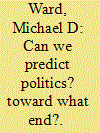

|
|
|
|
|
| Summary/Abstract |
In 1901, off the Greek island of Antikythera, a ship pulled into a bay to wait out a storm. After the storm was over, its divers discovered an ancient shipwreck containing many valuable antiquities, including jewelry, coins, statues, and pottery. One item was a lump of corroded bronze and wood. Everything was carted off to the National Museum of Archeology in Athens. In 1902, an archeologist noticed that the corroded lump had what appeared to be gears in it. He assumed that it was some sort of astrological clock, but it appeared to be too far advanced given the dating of the other items it was found with, which were initially dated to about 150 BCE, and it was ignored for five decades. Several years later, it was X and γ rayed, resulting in images of eighty-two different fragments of the device.
|
|
|
|
|
|
|
|
|
|
|
|
|
|
|
|
| 2 |
ID:
008968
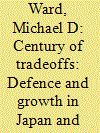

|
|
|
|
|
| Publication |
March 1995.
|
| Description |
27-50
|
|
|
|
|
|
|
|
|
|
|
|
|
|
|
|
| 3 |
ID:
134524
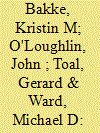

|
|
|
|
|
| Summary/Abstract |
De facto states, functional on the ground but unrecognized by most states, have long been black boxes for systematic empirical research. This study investigates de facto states’ internal legitimacy—people's confidence in the entity itself, the regime, and institutions. While internal legitimacy is important for any state, it is particularly important for de facto states, whose lack of external legitimacy has made internal legitimacy integral to their quest for recognition. We propose that the internal legitimacy of de facto states depends on how convincing they are to their “citizens” as state-builders. Using original data from a 2010 survey in Abkhazia, we examine this argument based on respondent perceptions of security, welfare, and democracy. Our findings suggest that internal legitimacy is shaped by the key Weberian state-building function of monopoly of the legitimate use of force, as well as these entities’ ability to fulfill other aspects of the social contract.
|
|
|
|
|
|
|
|
|
|
|
|
|
|
|
|
| 4 |
ID:
075223
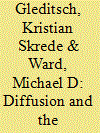

|
|
|
|
|
| Publication |
2006.
|
| Summary/Abstract |
Democracy does not evolve sui generis. The spatial clustering in democracy and transitions suggests that international factors play a prominent role in forging democracies as well as influencing their durability. We argue that democracy often comes about as a result of changes in the relative power of important actors and groups as well as their evaluations of particular institutions, both of which are often influenced by forces outside the country in question. The scope and extent of connections with other democratic countries in a region can strengthen support for democratic reform and help sustain institutions in transitional democracies. Results from a transition model demonstrate that international factors can exert a strong influence on the prospects for transitions to democracy, and the spatial clustering in democracy and transitions cannot adequately be explained by the hypothesized domestic social requisites of individual countries.
|
|
|
|
|
|
|
|
|
|
|
|
|
|
|
|
| 5 |
ID:
030399
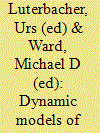

|
|
|
|
|
| Publication |
Colorado, Lynne Riener Publishers, Inc., 1985.
|
| Description |
xiv, 561p.
|
| Standard Number |
0931477182
|
|
|
|
|
|
|
|
|
|
|
|
Copies: C:1/I:0,R:0,Q:0
Circulation
| Accession# | Call# | Current Location | Status | Policy | Location |
| 026836 | 327.16/LUT 026836 | Main | On Shelf | General | |
|
|
|
|
| 6 |
ID:
116463
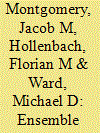

|
|
|
|
|
| Publication |
2012.
|
| Summary/Abstract |
For more than two decades, political scientists have created statistical models aimed at generating out-of-sample predictions of presidential elections. In 2004 and 2008, PS: Political Science and Politics published symposia of the various forecasting models prior to Election Day. This exercise serves to validate models based on accuracy by garnering additional support for those that most accurately foretell the ultimate election outcome. Implicitly, these symposia assert that accurate models best capture the essential contexts and determinants of elections. In part, therefore, this exercise aims to develop the "best" model of the underlying data generating process. Scholars comparatively evaluate their models by setting their predictions against electoral results while also giving some attention to the models' inherent plausibility, parsimony, and beauty.
|
|
|
|
|
|
|
|
|
|
|
|
|
|
|
|
| 7 |
ID:
121787
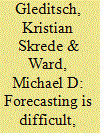

|
|
|
|
|
| Publication |
2013.
|
| Summary/Abstract |
Prediction is an important goal in the study of international conflict, but a large body of research has found that existing statistical models generally have disappointing predictive abilities. We show that most efforts build on models unlikely to be helpful for prediction. Many models essentially ignore the origins of conflict; studies look either at invariant structural features believed to affect the opportunities of conflict, or at factors that are believed to reduce the baseline risk of conflict, without attempting to identify the potential motivations and contentious issues over which conflicts typically arise. Researchers that have considered how contentious issues may motivate conflict and how these can be managed, using the Issues Correlates of War (ICOW) data, have not considered how these features may inform prediction. We assess the risk of dyadic interstate conflict based on the presence of specific contentious issues and conflict management events that may change the conflict potential of these contentious issues. We evaluate to what extent incorporating contentious issues and conflict management can help improve out-of-sample forecasting, as well as advance our understanding of conflict dynamics. Our results provide strong support for the idea that taking into account contentious issues can inform and improve out-of-sample forecasting.
|
|
|
|
|
|
|
|
|
|
|
|
|
|
|
|
| 8 |
ID:
126714
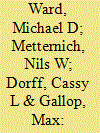

|
|
|
|
|
| Publication |
2013.
|
| Summary/Abstract |
Developing political forecasting models not only increases the ability of political scientists to inform public policy decisions, but is also relevant for scientific advancement. This article argues for and demonstrates the utility of creating forecasting models for predicting political conflicts in a diverse range of country settings. Apart from the benefit of making actual predictions, we argue that predictive heuristics are one gold standard of model development in the field of conflict studies. As such, they shed light on an array of important components of the political science literature on conflict dynamics. We develop and present conflict predictions that have been highly accurate for past and subsequent events, exhibiting few false-negative and false-positive categorizations. Our predictions are made at the monthly level for 6-month periods into the future, taking into account the social-spatial context of each individual country. The model has a high degree of accuracy in reproducing historical data measured monthly over the past 10 years and has approximately equal accuracy in making forecasts. Thus, forecasting in political science is increasingly accurate. At the same time, by providing a gold standard that separates model construction from model evaluation, we can defeat observational research designs and use true prediction as a way to evaluate theories. We suggest that progress in the modeling of conflict research depends on the use of prediction as a gold standard of heuristic evaluation.
|
|
|
|
|
|
|
|
|
|
|
|
|
|
|
|
| 9 |
ID:
152295
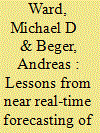

|
|
|
|
|
| Summary/Abstract |
Since 2014, we have been producing regular six-month forecasts of the probability of irregular leadership changes – coups, rebellions, protests that result in state leader changes – for most countries in the world for the Political Instability Task Force (PITF). During 2015, we issued new forecasts each month, with a delay as short as five days and no longer than two weeks into each six-month forecasting window. This article describes the approach we use to generate our forecasts and presents several examples of how we present forecasts. The forecasts are derived from a statistical ensemble of seven thematic models, each based on a split-population duration model that aims to capture a specific argument or related set of covariates. This approach is modular in that thematic models can be swapped out or new models integrated, and it lessens the need for generalist ‘kitchen sink’ models. Together, the models achieve high out-of-sample accuracy. Based on our experience, we draw conclusions about the practical, policy, and scientific aspects of this and similar undertakings. These include thoughts on how to evaluate and present forecasts, the potential role of ensembles in model comparison, the role of ensembles and prediction in causal research, and considerations for future efforts in forecasting and predictive modeling.
|
|
|
|
|
|
|
|
|
|
|
|
|
|
|
|
| 10 |
ID:
145703
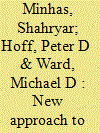

|
|
|
|
|
| Summary/Abstract |
Previous models of international conflict have suffered two shortfalls. They tend not to embody dynamic changes, focusing rather on static slices of behavior over time across a single relational dimension. These models have also been empirically evaluated in ways that assumed the independence of each country, when in reality they are searching for the interdependence among all countries. A number of approaches are available now for analyzing relational data such as international conflict in a network context and a number of these can even handle longitudinal relational data, but none are developed to the point of exploring how networks can coevolve over time. We illustrate a solution to the limitations of existing approaches and apply this novel, dynamic, network based approach to study the dependencies among the ebb and flow of daily international interactions using a newly developed, and openly available, database of events among nations.
|
|
|
|
|
|
|
|
|
|
|
|
|
|
|
|
| 11 |
ID:
098408


|
|
|
|
|
| Publication |
2010.
|
| Summary/Abstract |
Large-n studies of conflict have produced a large number of statistically significant results but little accurate guidance in terms of anticipating the onset of conflict. The authors argue that too much attention has been paid to finding statistically significant relationships, while too little attention has been paid to finding variables that improve our ability to predict civil wars. The result can be a distorted view of what matters most to the onset of conflict. Although these models may not be intended to be predictive models, prescriptions based on these models are generally based on statistical significance, and the predictive attributes of the underlying models are generally ignored. These predictions should not be ignored, but rather need to be heuristically evaluated because they may shed light on the veracity of the models. In this study, the authors conduct a side-by-side comparison of the statistical significance and predictive power of the different variables used in two of the most influential models of civil war. The results provide a clear demonstration of how potentially misleading the traditional focus on statistical significance can be. Until out-of-sample heuristics - especially including predictions - are part of the normal evaluative tools in conflict research, we are unlikely to make sufficient theoretical progress beyond broad statements that point to GDP per capita and population as the major causal factors accounting for civil war onset.
|
|
|
|
|
|
|
|
|
|
|
|
|
|
|
|
| 12 |
ID:
076876


|
|
|
|
|
| Publication |
2007.
|
| Summary/Abstract |
The authors examine a standard gravity model of international commerce augmented to include political as well as institutional influences on bilateral trade. Using annual data from 1980-2001, they estimate regression coefficients and residual dependencies using a hierarchy of models in each year. Rather than gauge the generalizability of these patterns via traditional measures of statistical significance such as p-values, this article develops and employs a strategy to evaluate the out-of-sample predictive strength of various models. The analysis of recent international commerce shows that in addition to a typical gravity-model specification, political and institutional variables are important. The article also demonstrates that the often-reported link between international conflict and bilateral trade is elusive, and that inclusion of conflict in a trade model can sometimes lead to reduced out-of-sample predictive performance. Further, this article illustrates that there are substantial, persistent residual exporter- and importer-specific effects, and that ignoring such patterns in relational trade data results in an incomplete picture of international commerce, even in the context of a well-established framework such as the gravity model
|
|
|
|
|
|
|
|
|
|
|
|
|
|
|
|
| 13 |
ID:
034318
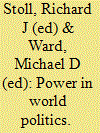

|
|
|
|
|
| Publication |
Boulder, Lynne Rienners Puublishers, 1989.
|
| Description |
ix, 242p.
|
| Standard Number |
1555871259
|
|
|
|
|
|
|
|
|
|
|
|
Copies: C:1/I:0,R:0,Q:0
Circulation
| Accession# | Call# | Current Location | Status | Policy | Location |
| 032252 | 327.1/STO 032252 | Main | On Shelf | General | |
|
|
|
|
| 14 |
ID:
101683
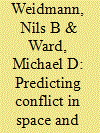

|
|
|
|
|
| Publication |
2010.
|
| Summary/Abstract |
The prediction of conflict constitutes a challenge to social scientists. This article explores whether the incorporation of geography can help us make our forecasts of political violence more accurate. The authors describe a spatially and temporally autoregressive discrete regression model, following the framework of Geyer and Thompson. This model is applied to geo-located data on attributes and conflict events in Bosnia over the period from March 1992 to October 1995. Results show that there is a strong spatial as well as temporal dimension to the outbreak of violence in Bosnia. The authors then explore the use of this model for predicting future conflict. Using a simulation approach, the predictive accuracy of the spatial-temporal model is compared to a standard regression model that only includes time lags. The results show that even in a difficult out-of-sample prediction task, the incorporation of space improves our forecasts of future conflict.
|
|
|
|
|
|
|
|
|
|
|
|
|
|
|
|
| 15 |
ID:
180673
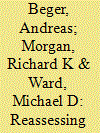

|
|
|
|
|
| Summary/Abstract |
We examine the research protocols in Blair and Sambanis’ recent article on forecasting civil wars, where they argue that their theory-based model can predict civil war onsets better than several atheoretical alternatives or a model with country-structural factors. We find that there are several important mistakes and that their key finding is entirely conditional on the use of parametrically smoothed ROC curves when calculating accuracy, rather than the standard empirical ROC curves that dominate the literature. Fixing these mistakes results in a reversal of their claim that theory-based models of escalation are better at predicting onsets of civil war than other kinds of models. Their model is outperformed by several of the ad hoc, putatively non-theoretical models they devise and examine. More importantly, we argue that rather than trying to contrast the roles of theory and “atheoretical” machine learning in predictive modeling, it would be more productive to focus on ways in which predictive modeling and machine learning could be used to strengthen extant predictive work. Instead, we argue that predictive modeling and machine learning are effective tools for theory testing.
|
|
|
|
|
|
|
|
|
|
|
|
|
|
|
|
| 16 |
ID:
086960
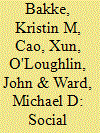

|
|
|
|
|
| Publication |
2009.
|
| Summary/Abstract |
This article examines attitudinal differences and similarities among ethnic groups in conflict-affected societies. Conventional wisdom tells us that societies that have experienced violent struggles in which individuals of different ethnic groups have (been) mobilized against each other are likely to become polarized along ethnic lines. Indeed, both policy-makers and scholars often assume that such divisions are some of the main challenges that must be overcome to restore peace after war. We comparatively examine this conventional wisdom by mapping dimensions of social distance among 4,000 survey respondents in Bosnia-Herzegovina and the North Caucasus region of Russia. The surveys were carried out in December 2005. Using multidimensional scaling methods, we do not find patterns of clear attitudinal cleavages among members of different ethnic groups in Bosnia-Herzegovina. Nor do we find patterns of clear ethnic division in the North Caucasus, although our social distance matrices reveal a difference between Russians and ethnic minority groups.
|
|
|
|
|
|
|
|
|
|
|
|
|
|
|
|
|
|
|
|
|